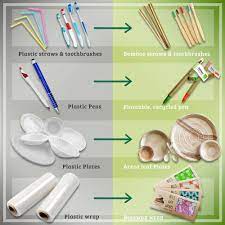07 Jul 2022 Alternatives to Plastic: NITI Aayog

Alternatives to Plastic: NITI Aayog – Today Current Affairs
- Recently NITI Aayog has released a report titled ‘Alternative Products and Technologies for Plastics and their Applications’ to encourage the use of alternatives to plastics.
- The Ministry of Environment, Forest and Climate Change has also banned Single Use Plastic (SUP), violating this ban will attract penal action under Section 15 of the Environment Protection Act (EPA).
Today Current Affairs
Key features of the report:
Global Plastics Production and Disposal : The Hindu Analysis
- Cumulative production of polymers, synthetic fibers and additives “between” 1950-2015 was 8,300 million tonnes, of which 55% was dumped directly into landfills or 8% incinerated and only 6% of plastics were recycled.
- If production is continued at this rate till the year 2050, it will produce 12,000 metric tons of plastic.
Case of India : The Hindu Analysis
- India produced 47 million tonnes of plastic waste annually, of which per capita waste increased from 700 grams to 2,500 grams in the last five years.
- Goa, Delhi and Kerala generated the highest per capita plastic waste, while Nagaland, Sikkim and Tripura generated the lowest per capita plastic waste.
Challenge : The Hindu Analysis
- Globally, 97–99% of these plastics are derived from fossil fuel feedstocks, while the remaining 1-3% is bio (plant) based plastics.
- Only a small portion of this plastic waste is recycled, as it is believed that the majority of this waste is expelled into the environment through various polluting routes.
- India collects only 60% of its plastic waste and the remaining 40% remains uncollected which directly enters the environment as waste. The Hindu Analysis
- Almost every piece of plastic begins as a fossil fuel, and greenhouse gases (GHG) are emitted at each stage of the plastic lifecycle:
- Fossil fuel extraction and transportation
- Plastics Refining and Manufacturing
- Management of plastic waste
- Impact on oceans, waterways and various ecosystem landscapes
Initiative : The Hindu Analysis
- The most preferred option for waste management is waste reduction. Strengthen the waste reduction campaign through Extended Producer Responsibility (EPR), proper labeling and composting and collection of biodegradable plastics, while relaxing the timelines for adoption of biodegradable plastics.
- Developing emerging technologies, for example additives that can convert plastics into biodegradable polyolefins, such as polypropylene and polyethylene.
Uses of Bio-Plastics : The Hindu Analysis
- As an economical alternative to plastics.
- To encourage R&D and manufacturing sector.
- Increase transparency in the disclosure of waste generation, collection, recycling or scientific disposal to set accountability and avoid greenwashing.
- Greenwashing is a process of providing misleading information about how a company’s products are environmentally sound.
Plastic option:
Glass : The Hindu Analysis
- Glass has always been the safest and most viable option for packaging and use of food and liquids.
- Glass can be recycled multiple times, so it does not end up in landfills. It is cost effective given its durability and recyclability.
Bagasse : The Hindu Analysis
- Compostable eco-friendly bagasse can eliminate the need for plastic in the form of disposable plate cups or boxes.
- After extracting the juice from sugarcane or beet, bagasse is made from the remaining pulp. It can also be used for other purposes like biofuel.
Bioplastics : The Hindu Analysis
- Plant-based plastics, known as bioplastics, are touted as a green alternative to fossil fuel-based plastics, especially when it comes to food packaging.
- But bioplastics have their own environmental footprint, which requires growing crops and using land and water.
- Bioplastics are considered to be just as harmful and in some cases more harmful than conventional plastics.
Natural Fabrics : The Hindu Analysis
- Millions of tiny plastic fibers are shed with each wash, making cotton, wool, linen and hemp the traditional choice when it comes to replacing polyester and nylon fabrics.
- Production of cotton is posing a serious threat to the environment.
Refill, reuse and buy unpacked : The Hindu Analysis
- Least harmful packaging is one that can be used repeatedly or not at all.
- Reusable cloth bags for fruits and vegetables etc.
- Reusable containers and boxes for meat, fish, cheese etc.
- Refillable bottles and jars for oil and vinegar, cleaning liquids, etc.
- Wrapping Beeswax instead of Foil and Clingfilm.
In this article we mention all information about Alternatives to Plastic: NITI Aayog Today Current Affairs.


No Comments